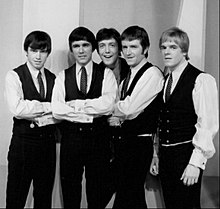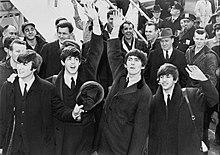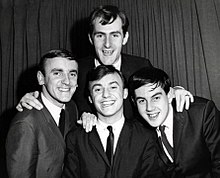Beat music
Beat music, British beat, or Merseybeat (after bands from Liverpool and nearby areas beside the River Mersey) is a pop and rock music genre that developed in the United Kingdom in the early 1960s. Beat music is a fusion ofrock and roll (mainly Chuck Berry guitar style and the midtempo beat ofLubbock sound artists like Buddy Holly), doo-wop, skiffle and R&B. The genre provided many of the bands responsible for the British Invasion of the American pop charts starting in 1964, and provided the model for many important developments in pop and rock music, including the format of therock group around lead, rhythm and bass guitars with drums.
Use of the term
The exact origins of the terms 'beat music' and 'Merseybeat' are uncertain. Beat music seems to have had little to do with the Beat Generation literary movement of the 1950s, and more to do with driving rhythms, which the bands had adopted from their rock and roll, rhythm and blues and soul music influences. As the initial wave of rock and roll declined in the later 1950s "big beat" music, later shortened to "beat", became a live dance alternative to the balladeers like Tommy Steele,Marty Wilde and Cliff Richard who were dominating the charts.
The name Mersey Beat was used for a Liverpool music magazine founded in 1961 by Bill Harry. Harry claims to have coined the term "based on a policeman's beat and not that of the music". The band the Pacifics were renamed the Mersey Beats in February 1962 by Bob Wooler, MC at the Cavern Club and in April that year they became The Merseybeats. With the rise of the Beatles in 1963, the terms Mersey sound and Merseybeat were applied to bands and singers from Liverpool, and this was the first time in British pop music that a sound and a location were linked together.The equivalent scenes in Birmingham and London were described as Brum beat and the Tottenham Sound respectively.
Characteristics
The most distinctive characteristic of the music was the strong beat, using the backbeat common to rock and roll andrhythm and blues, but often with a driving emphasis on all the beats of 4/4 bar. The rhythm itself—described by Alan Clayson as "a changeless four-four offbeat on the snare drum"—was developed in the clubs in Hamburg, Germany, where many English groups, including the Beatles, performed in the early 1960s and where it was known as the mach schaubeat. The 8/8 rhythm was flexible enough to be adopted for songs from a range of genres. In addition, according to music writer Dave Laing,
Beat groups usually had simple guitar-dominated line-ups, with vocal harmonies and catchy tunes. The most common instrumentation of beat groups featured lead, rhythm and bass guitars plus drums, as popularised by The Beatles, The Searchers, Gerry & The Pacemakers and others. Beat groups—even those with a separate lead singer—often sang both verses and choruses in close harmony, resembling doo wop, with nonsense syllables in the backing vocals.
History
In the late 1950s, a flourishing culture of groups began to emerge, often out of the declining skiffle scene, in major urban centres in the UK like Liverpool, Manchester, Birmingham and London. This was particularly true in Liverpool, where it has been estimated that there were around 350 different bands active, often playing ballrooms, concert halls and clubs. Liverpool was perhaps uniquely placed within Britain to be the point of origin of a new form of music. Commentators have pointed to a combination of local solidarity, industrial decline, social deprivation, and the existence of a large population of Irish origin, the influence of which has been detected in Beat music. It was also a major port with links to America, which made for much greater access to American records and instruments like guitars, which could not easily be imported due to trade restrictions. As a result Beat bands were heavily influenced by American groups of the era, such as Buddy Holly and the Crickets (from which group The Beatles gained the model for their name, combining it with a pun on the beat in their music), and to a lesser extent by British rock and roll groups such as The Shadows.
After the national success of The Beatles in Britain from 1962, a number of Liverpool performers were able to follow them into the charts, including Gerry & The Pacemakers, The Searchers, and Cilla Black. The first act who were not from Liverpool or managed by Brian Epstein to break through in the UK were Freddie and the Dreamers, who were based in Manchester, a short distance away, as were Herman's Hermits and The Hollies.
Outside of Liverpool many local scenes were less influenced by rock and roll and more by the rhythm and blues and later directly by the blues. These included bands from Birmingham who were often grouped with the beat movement, the most successful being The Spencer Davis Group and The Moody Blues. Similar blues influenced bands who broke out from local scenes to national prominence were The Animals from Newcastle and Them from Belfast. From London, the termTottenham Sound was largely based around The Dave Clark Five, but other London-based British rhythm and blues bands who benefited from the beat boom of this era included The Rolling Stones,The Kinks and The Yardbirds.
British Invasion
Main article: British Invasion
The term British Invasion was coined by T.V. reporter Walter Cronkite to describe the Beatles' arrival in the United States and the outbreak of Beatlemania in 1964. Their appearance on The Ed Sullivan Show soon after led to chart success. During the next two years, the Animals, Petula Clark, The Dave Clark Five the Rolling Stones, Donovan, Peter and Gordon, Manfred Mann, Freddie and the Dreamers, Wayne Fontana and the Mindbenders, Herman’s Hermits, and The Troggs would have one or more number one singles in America.
Decline and influence
By 1967 beat music was beginning to sound out of date, particularly compared with the "harder edged" blues rock that was beginning to emerge. Most of the groups that had not already disbanded moved, like The Beatles, into different forms of rock music and pop music, includingpsychedelic rock and eventually progressive rock Beat was a major influence on the American garage rock and folk rock movements, and would be a source of inspiration for subsequent rock music subgenres, including Britpop in the 1990s.
Notable artists
Merseybeat
- The Beatles
- The Big Three
- The Cryin' Shames
- Lee Curtis and the All-Stars
- The Dakotas
- Derry and the Seniors
- The Escorts
- The Fourmost
- Gerry and the Pacemakers
- Billy J. Kramer
- The Liverbirds
- The Merseybeats
- The Mindbenders
- The Mojos
- Rory Storm and the Hurricanes
- Kingsize Taylor and the Dominoes
- The Searchers
- The Swinging Blue Jeans
- The Undertakers
Other British beat groups
- The Animals
- The Applejacks
- The Honeycombs
- Cliff Bennett and the Rebel Rousers
- The Dave Clark Five
- Freddie and the Dreamers
- Herman's Hermits
- The Hollies
- The Kinks
- Manfred Mann
- The Pretty Things
- The Rolling Stones
- The Small Faces
- The Troggs
- The Who
- The Zombies
















No comments:
Post a Comment